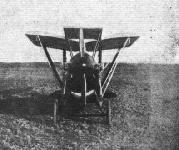Loughead S-1
Несмотря на то, что Loughead S-1 не имел таких успешных продаж, как предполагалось, он оказался важной вехой на пути развития самолетов компании. В частности, был внедрен новый метод постройки деревянных фюзеляжей типа монокок, и была заложена база для создания последующего семейства самолетов Vega.
S-1 представлял собой легкий одностоечный биплан, отличавшийся складывающимися крыльями бипланной коробки (машину можно фактически хранить в частном гараже). Первоначально намечалось использовать двигатель Green британской постройки, но по причине развала компании пришлось взять взамен двигатель XL-1 мощностью 25 л. с. Первый полет состоялся либо в конце 1919 года, либо в начале 1920 года. Несмотря на довольно привлекательную конструкцию, интереса к самолету проявлено не было, и компания-разработчик прекратила свою деятельность.
ТАКТИКО-ТЕХНИЧЕСКИЕ ХАРАКТЕРИСТИКИ
Loughead S-1
Тип: 1-местный спортивный самолет
Силовая установка: один двухцилиндровый ПД жидкостного охлаждения Stadlman XL-1 мощностью 25 л. с. (19 кВт)
Летные характеристики: максимальная скорость 113 км/ч; практический потолок 3658 м; максимальная продолжительность полета при запасе топлива 30 литров - 8 часов
Масса: пустого снаряженного 170 кг; максимальная взлетная 374 кг
Размеры: размах крыльев бипланной коробки 8,53 м; длина 6,10 м; высота 2,21м
Показать полностьюShow all
Flight, August 1920
AN AMERICAN SINGLE-SEATER WITH NOVEL FEATURES
DURING the last few years very little originality in design has been shown by the aircraft manufacturers in the United States. For the most part they have been content to copy European models, generally evolving rather poor imitations at that. Occasionally there are exceptions. One of the chief exhibits at the recent San Francisco aero exposition was a small biplane especially built for pleasure purposes by the Loughead Aircraft Manufacturing Co. of Santa Barbara, California, and there are so many novel and interesting features about this machine, that it is worth describing in detail. The Loughead S1 model, as it is called, is a single-seater biplane with a wing span of 28 ft., and a total weight empty of only 400 lbs. Although there are traces of the well-known German Albatros having been used as a model, everything about this little aeroplane denotes a refinement and finish worthy of the best French and English machines, and lacking in most American craft.
The fuselage is of monocoque form, consisting of a thin shell of plywood reinforced by transverse bulkheads. Though not very common in England, this type of fuselage has long been acknowledged to be the most successful, both on account of its ideal streamline form and its strength in proportion to its weight. Heretofore it has, however, been little used on account of the laborious methods necessary, which made it exceedingly expensive. The shell in the Loughead model is produced by applying three complete layers of plywood to a mould the shape of the body; binding cloth and casein glue being applied between the layers, which are then subjected to a uniform air pressure of 20 lbs. to the square inch, which is maintained over the entire surface until the glue has set. This process produces a wooden shell of a uniform thickness of 1/8-inch, which is said to be stronger for its weight than any other fuselage yet developed. The whole body presents a perfect streamline form from the pot on the propeller boss to the rear end, where it runs into a sharp point beyond the rudder and tail plane, and not ending in the knife-edge common to most European machines.
The upper and lower wings are supported by a V-shaped strut near the wing tips, which is solidly bolted to the upper wing spars and fastened to the lower wing by a simple but rigid pin connection. The most novel and original features of the machine are the air-brake and the position of the radiator. In the former, the lower wing spar is made to pivot at the body, allowing the whole wing to rotate, not only forming a very efficient lateral control, but allowing the lower wings to be thrown into a vertical position which provides, it is claimed, an extremely effective brake, making it possible to stop the plane within from 50 to 75 ft. of the point where the wheels first touch the ground. This brake is operated by a separate lever placed at the side of the pilot's seat. The designers claim that the machine will land at the exceedingly low speed of 25 m.p.h., while its maximum speed is said to be 75 m.p.h. The power plant consists of a 2-cylinder water-cooled motor of only 25 h.p. designed by the same firm. The Loughead motor weighs approximately 90 lbs., has two horizontally opposed cylinders with a bore of 3 5/8 ins. and a stroke of 4 1/2 ins. There are two independent Bosch magnetos, and two high-pressure gear-type oil pumps; the radiator, as noted above, being mounted in a novel position, immediately under the fuselage. The fuel tank, of 7 gallons capacity, is located in the centre section of the upper wing. Fuel consumption is claimed at only one gallon per hour, and oil at one-half pint per hour at economical speed. The landing gear is of the usual V-strut and rubber band type with a factor of safety of over 10 to 1. There are only five wires on each side of the body - three flying, one landing, and one drift, all being neatly faired to lessen head resistance. There are no control wires outside the fuselage. The propeller is only 5 ft. 6 ins. in diameter, with a pitch of 3 ft. 6 ins. There is a large unbalanced rudder and a vertical tail fin. Lateral control is obtained neither by ailerons nor by warping, but by pivoting the lower wing just forward of the centre of pressure, a method eliminating all the lost motion found in the conventional cable and pulley systems.
A special feature which will commend itself to all private owners is the patented wing-folding device reducing the housing space required to such an extent that any good garage or shed 10 ft. by 20 ft. is a suitable hangar.
Показать полностьюShow all




